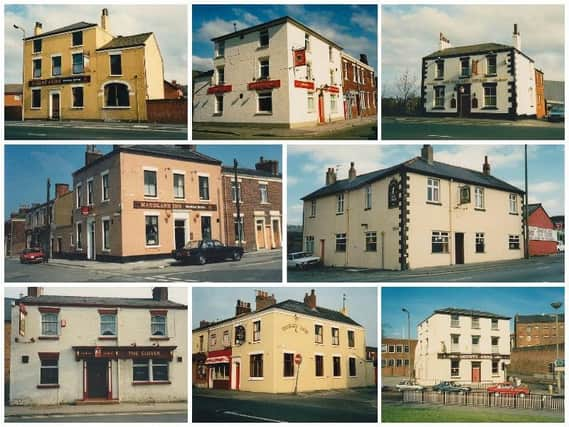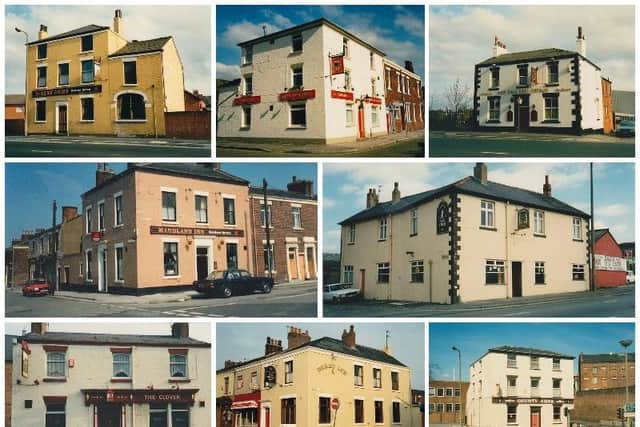LAST ORDERS: Looking back at Preston's long lost public houses


Preston has, down the centuries, had no shortage of public houses; there being home to no less than 460 inns, taverns or simple beer houses in late Victorian days.
Nostalgia seems to surface whenever a public house closes its doors and certainly Preston’s old inns are no exception. Those with memories that go back before the Second World War will tell you of the Craven Heifer on North Road noted for its home brewed ales.


Advertisement
Hide AdAdvertisement
Hide AdYes, that great North Road that, before the Ringway was developed, stretched from Church Street through to Garstang Road.
Along its length such licensed premises as the Sir Walter Scott, the Queen’s Hotel, the Hero of Vittoria, the Three Tuns, the Sitting Goose and the Apollo – all hoping to tempt the thirsty traveller. Along with the Mill Tavern, Iron Duke, Old Royal George, New Royal George and a Lord Nelson on the corner of Sedgwick Street.
And then there was a New Inn, Garricks Head, Rose and Crown, Burns Hotel, Bay Horse Inn, Morning Star, Church Hotel and Commercial Inn – all just a short walk away for local folk in the neighbouring streets.
New Hall Lane, an area which developed as John Horrocks built his cotton empire, is a road well known for its public houses and many have claimed to have drunk a pint in every inn along its way before reaching the Preston Cemetery gates.
Advertisement
Hide AdAdvertisement
Hide AdA trip from the Rosebud, at the junction with London Road, which was demolished in 1988, to the Hesketh Arms would have left few souls sober after visits in the 1960s to the likes of the Carter’s Arms, Queen Adelaide, General Codrington, New Hall Lane Tavern, Gibraltar Inn, Birley Arms, Belle Vue and Acregate. Of most there is no trace, on the site of the Queen Adelaide is a Polish store, whilst a Lidl store and a Bingo Hall now stand where the New Hall Tavern, closed in 2001, once stood with its near neighbours the General Codrington and the Gibraltar Inn.
While the Acregate closed in 2008, the old Birley Arms was revamped and turned into a solicitor’s offices and the once popular Belle Vue is now the Maya Delikatesy store.
Yet that lane paled into insignificance when a journey along the almost parallel Ribbleton Lane was undertaken. Beginning at the County Arms, which was recently reduced to bricks and rubble, a stag party of 80 years ago could hopefully visit the Old Oak, Star Hotel, Anchors Weighed, Albert Hotel, Guild Inn, New Sun Inn, Birchall’s Arms, Third Duke Of Lancaster, Fox and Grapes, Bold Venture, Derby Inn, Skeffington Arms and Old England – all before last orders. Many closed in distant times being joined by the Derby Inn and nearby Cemetery Hotel in recent times.
Many a regular has had a lump in their throat or wiped a tear from their eyes as they have drunk the last pint in their beloved local. To many an Englishman his home is his castle, and his inn a palace of pleasure. The names still conjure up memories: the Anglers Inn was demolished in 1968 after serving the town since 1840. It was a reminder of the heyday of Matthew Brown, with the figure of an angler above its entrance. The Boars Head bowed to the developers who coveted the prime Friargate site, closing in 1983 and, two years later, its near neighbour the Waterloo Inn put the shutters up.
Advertisement
Hide AdAdvertisement
Hide AdThe frequenters of Lune Street will tell you of the Corporation Arms that became a casualty of the Ring Road development in the late 1960s. Regulars would never tire of showing folk where musket balls had struck the exterior of the building during the riot of 1842.
The last drinks were served at the Theatre Hotel on Fishergate one lunchtime in mid October 1987. At the corner of Orchard Street and Market Street once stood the Farmer’s Arms – a traditional calling place for farmers who hauled their produce overnight by horse drawn wagons.
The magnificent three-storey building was somewhat rundown by the late 1960s and was taken over by the Chef and Brewer group who turned it into the Jolly Farmer, a trendy place for young and old. Alas, by 1980, its prime position made it a target for the developers who paid £400,000 and turned it into shop units. Down the ancient passageway known as New Cock Yard was the New Cock Inn that was in fact the back portion of the old mansion of Thomas Winckley. It was long famous for its strong beer and its demolition made way for the Boots Chemist store fronting on to Fishergate.
In the summer of 1969 the town said farewell to the Port Admiral public house which stood on Lancaster Road at its junction with Saul Street. Ringway was about to sweep through and the first priority was to remove the landmark stone statues from its roof.
Advertisement
Hide AdAdvertisement
Hide AdNapoleon and Nelson together with a woman, naked except for a fig leaf, and reputed to be Lady Emma Hamilton, were carefully removed, along with the four crouching lions which looked out from each corner.
The new road also laid claim to the Painters Arms on High Street’s corner with Lawson Street.
Along Meadow Street and the neighbouring streets drinkers would regularly go from inn to tavern, but now the public houses are not so frequent.
The old Meadow Arms, later Mister Pickwick’s, is a derelict ruin and its neighbour the Clover Inn a home to students, as is the nearby Stone Cottage. While the Hyde Park Inn on St. Paul’s Road is no more and the nearby Windsor Castle, Red Rose Inn formerly the Edinburgh Castle, and the old Stephenson’s Arms, more recently trading as Churchill’s, have put up the shutters.
Advertisement
Hide AdAdvertisement
Hide AdWander around the area close to our university and it is noticeable that the Watering Trough on Fylde Road and the neighbouring Princess Alexandra both advertise accommodation for students, as do the Maudland Inn on Peddar Street and the old Hornby Castle and The Cottage on Brook Street, while the old Doctor Syntax is a place for food.
The UCLan Student Guide of 1993 welcomed students for the new term with a Pub Guide listing 140 local inns or taverns – the list indeed is shorter now. The drinks no longer flow at the North Star, nor at the Neptune on Strand Road, the Springfield or Oak Tree on Marsh Lane, nor the Lovat on Lovat Road, or the Cross Keys, nor indeed on Aqueduct Street at the old Hermon Inn, Prince Consort or Lime Kiln.
The Kings Arms, the Lamb Hotel, of folk music fame, and the George Hotel long ago called time, as indeed has the Guild Tavern after days as Lionels Bar. Head to Plungington and only the Wellfield and Plungington Hotel will still greet you, for the Royal Oak is now a Pizza Hut, the old General Havelock is a property shop, while the shutters are up at the Plungington Tavern and the Tanners Arms is another home for students.
The Boatman’s on Marsh Lane no longer affords a welcome, nor is there a Brunswick on Charlotte Street, or the Spindlemakers or Crystals on Lancaster Road. The old Balmoral building looks forlorn on Manchester Road, while the former King Street Tavern is no more. Back in 1989 along Avenham Lane you could quench your thirst at the Palatine, Frenchwood Tavern or the Avenham Park Inn. The Cheethams Arms, William IV and Shawes Arms have gone from London Road.
Advertisement
Hide AdAdvertisement
Hide AdThe old Mitre Tavern on Moor Lane is a place to take your pets, whilst the Moorbrook Inn on North Road has recently lost its neighbour the Unicorn. The Cricketers Arms is derelict, the old New Ship Inn, Fylde Tavern, North Euston, the Brookhouse and Fox and Duck are now closed, the Prince Arthur and the Dukes of Kent, Sussex, Cambridge and York are long gone.
l Thanks to Steve Halliwell for help with the images. Visit Steve’s excellent Pubs in Preston blog at http://pubsinpreston.blogspot.com/